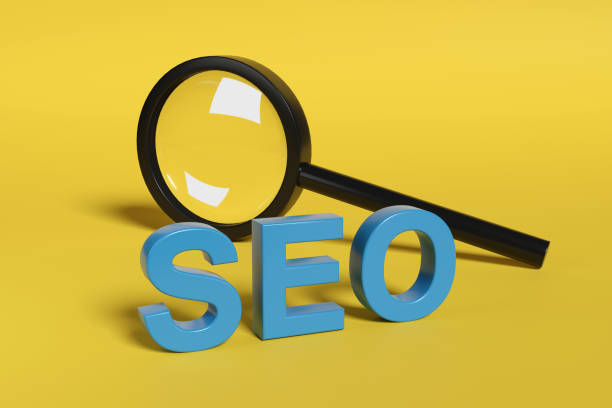Introduction to SEO and its Fundamental Importance

In today’s highly competitive digital world, your website’s visibility is crucial for business success.
This is where the concept of #SEO or Search Engine Optimization comes in.
SEO is a set of techniques and strategies performed with the aim of increasing the ranking and visibility of a website in the organic (non-paid) search results of search engines like Google, Bing, and Yahoo.
When a user searches for a phrase on Google, the search engine displays the best and most relevant results using its complex algorithms.
The main goal of SEO is to ensure your website ranks among these top results, as users primarily click on links found on the first page.
Without a strong SEO strategy, even the best content and services may go unnoticed.
SEO not only increases your website’s traffic but also helps improve traffic quality; meaning it attracts visitors who are genuinely interested in your products or services.
This educational process requires specialized knowledge and a deep understanding of how search engines work and user behavior.
Continuous optimization is a complex and time-consuming process that yields stable and lasting results.
With the help of SEO, businesses can more effectively reach their target audience and ultimately achieve their business goals.
Therefore, learning and properly implementing SEO is considered a long-term investment for any online business.
This comprehensive guide will familiarize you with various aspects of SEO.
Are you losing business opportunities because of an outdated website? With Rasaweb, permanently solve the problem of not attracting potential customers through your website!
✅ Attracting more high-quality leads
✅ Increasing brand credibility in the eyes of customers
⚡ Get free consultation for corporate website design
How Do Search Engines Rank Websites?

To understand how SEO works, it’s essential to first become familiar with how search engines operate.
Search engines use three main stages to deliver results: Crawling, Indexing, and Ranking.
In the crawling stage, search engine robots, also known as spiders or crawlers, follow web pages across the internet.
They follow links and collect page content.
This process is similar to navigating a vast network.
Then, in the indexing stage, the information collected by crawlers is stored in a massive database.
This database is essentially an organized directory of all pages and their content, allowing the search engine to quickly retrieve information.
Content quality and structure are of great importance at this stage.
Finally, the ranking stage occurs when a user enters a search query.
At this stage, complex search engine algorithms come into play.
These algorithms evaluate hundreds of factors to determine the most relevant and highest-quality pages for the searched phrase.
Factors such as keyword relevance, content quality and freshness, page loading speed, user experience, backlinks (incoming links from other websites), and domain authority all play a role in this evaluation.
The ultimate goal of search engines is to provide the best possible experience to users.
Therefore, a site that best meets the user’s needs and is also technically optimized will achieve a higher ranking.
Understanding this explanatory and analytical process is a fundamental step for any SEO specialist.
This understanding helps us optimize our website in a way that is both comprehensible to search engines and appealing and useful to users.
In fact, all SEO efforts are built upon these three fundamental stages to ensure our website appears in top results and attracts high-quality organic traffic.
Keyword Research: Why and How?

Keyword research is the backbone of any successful SEO strategy.
Without understanding what words and phrases your target audience uses to find your products or services, your SEO efforts will be fruitless.
This process involves discovering, analyzing, and selecting words and phrases that users are likely to type into search engines.
The main goal is to find keywords with suitable search volume and manageable competition.
The steps for keyword research include: First, brainstorm and use your knowledge about your business and audience to create a list of initial words and phrases.
Then, use keyword research tools like Google Keyword Planner, Ahrefs, Semrush, or Moz Keyword Explorer to expand this list and view data such as search volume, competition level, and related keywords.
Paying attention to User Intent is highly important; Is the user looking for information (informational keywords), making a purchase (commercial/transactional keywords), or searching for a specific website (navigational keywords)? Choosing keywords that align with user intent increases the chance of converting a visitor into a customer.
Also, paying attention to Long-Tail Keywords, which consist of three or more words, can be very effective.
These keywords usually have lower search volume but also less competition, and the user’s intent is more specific within them, leading to higher conversion rates.
This section is a comprehensive educational and guidance for understanding this fundamental SEO factor.
Accurate and continuous keyword research not only helps with better ranking but also gives you deeper insights into your audience’s needs and interests, which you can use to create more engaging and appealing content.
| Keyword Type | Description | Example |
|---|---|---|
| Informational | User is looking for information. | “What is SEO?”, “Benefits of organic fruits” |
| Transactional (Commercial) | User intends to buy or perform an action. | “Buy iPhone”, “Dell laptop price” |
| Navigational | User is looking for a specific website or brand. | “Digikala”, “Instagram login” |
| Long-Tail | Long and specific phrases with clear intent. | “Best way to learn SEO for beginners”, “How to cook Ghormeh Sabzi stew” |
On-Page SEO and Content Optimization

On-Page SEO refers to a set of actions performed within your website to improve its ranking in search engines.
These actions include optimizing your pages’ content and HTML elements.
The first and perhaps most important element is the Title Tag.
This tag is the first thing users see in search results and should contain main and attractive keywords to increase the click-through rate (CTR).
The Meta Description, although not directly affecting ranking, plays an important role in attracting users to click on your link and should be a summary of the page’s content with a Call to Action.
Proper use of Heading tags (H1 to H6) is crucial for structuring content and improving readability for both users and search engines.
H1 should be the main title of the page and used only once per page, while H2 to H6 are used for subheadings.
High-quality and comprehensive content is the heart of On-Page SEO.
Your content should be relevant, valuable, unique, and optimized for keywords without resorting to Keyword Stuffing.
Also, optimizing images with descriptive Alt tags containing keywords helps search engines understand the image content.
Internal Linking, which connects different pages of your website to each other, helps both users with navigation and search engines with crawling and understanding the website’s structure.
Page loading speed and mobile compatibility are also vital On-Page SEO factors that directly impact user experience.
These aspects of SEO require specialized attention and strict adherence to guidelines to achieve the best results.
Is your current e-commerce website design not generating the sales you expect?
Rasaweb specializes in professional e-commerce website design!
✅ An attractive and user-friendly website aimed at increasing sales
✅ High speed and security for an ideal shopping experience⚡ Get free consultation for online store design with Rasaweb!
Technical SEO and Its Role in Website Health

Technical SEO deals with optimizing your website’s infrastructure so that search engines can easily crawl, index, and rank your pages.
This aspect of SEO is often invisible to users but is crucial for the overall site performance.
One of the most important factors is page loading speed.
Both users and search engines value speed; slow pages lead to high Bounce Rates and poor user experience, both of which harm SEO ranking.
Using tools like Google PageSpeed Insights is essential for identifying and resolving speed-related issues.
The next item is Mobile-Friendliness.
Given the ever-increasing number of searches via mobile devices, Google penalizes websites that are not optimized for mobile.
Responsive Design, which displays your site well on any screen size, is the best solution.
XML Sitemaps help search engines discover and index all important pages of your website.
The robots.txt file instructs search engines which parts of your website not to crawl.
Using the HTTPS protocol (with SSL certificate installation) not only increases website security but is also considered a positive ranking factor.
Structured Data or Schema Markup also help search engines better understand your content and display it in richer forms (like rich snippets) in search results.
Proper management of 404 pages, 301 redirects, and fixing crawl errors are also part of Technical SEO that helps your website’s health and optimal performance.
This is a very specialized and explanatory part of optimization that directly affects your site’s SEO credibility.
Off-Page SEO and Building Online Authority

Off-Page SEO refers to all actions performed outside your website to improve its ranking in search engines.
The most important and influential factor in Off-Page SEO is Backlinks or incoming links from other websites.
Search engines consider backlinks as a “vote of confidence” from other websites for your content.
The more numerous and higher quality your backlinks are, the more your website’s authority in the eyes of search engines will increase, thereby achieving a better ranking.
But more important than quantity is the quality of backlinks.
A backlink from a reputable, relevant website with high domain authority is far more valuable than many links from low-quality or spammy sites.
There are various strategies for link building, including: creating very high-quality and valuable content that naturally attracts links (link bait), Guest Posting on relevant blogs, Broken Link Building on other sites and asking them to link to your content, and collaborating with influencers.
In addition to backlinks, other factors also play a role in Off-Page SEO.
Presence and activity on social networks can help increase brand awareness and drive traffic to the website, although its direct impact on SEO ranking is less than that of backlinks.
Brand Mentions on various websites and forums can also be a positive signal for search engines.
Online Reputation Management and user Reviews also indirectly affect SEO, as they increase user credibility and trust.
This analytical and guidance section emphasizes the importance of building authority and trust outside your website for overall SEO improvement.
Content, the Undisputed King in SEO

In the world of SEO, there is a golden saying: “Content is King” or “Content is King”.
No amount of technical optimization or off-page link building can replace high-quality, valuable content.
Content not only creates appeal for users but also helps search engines better understand your website and rank it for relevant search queries.
The main goal of content creation in SEO is to fully and comprehensively address user intent.
This means providing the information the user is looking for, in an understandable and engaging way.
There are various types of content you can use for your SEO strategy: blog articles, comprehensive guides, videos, infographics, podcasts, case studies, and even engaging or entertaining content that goes viral.
Each type of content should be produced with target keywords and user intent in mind.
Your content must be unique, accurate, and up-to-date.
Avoid plagiarism, as this can lead to severe penalties from search engines.
In addition to quality, content length can also play a role; generally, longer and more comprehensive content that covers all aspects of a topic has a greater chance of ranking.
Proper content structuring using headings, lists, and short paragraphs improves readability and keeps users on the page longer.
Keeping users on the page sends a positive signal to search engines.
Remember that a strong content strategy is the foundation for long-term SEO success.
| Type of Content | Application in SEO | Example |
|---|---|---|
| Blog Articles | Attracting informational traffic, answering user questions, building authority | “10 Ways to Increase Website Speed”, “Complete SEO Guide” |
| Comprehensive Guides | In-depth and specialized content, attracting natural backlinks, lead conversion | “Step-by-Step Website Design Guide”, “Comprehensive Digital Marketing Course” |
| Videos | Increasing user dwell time, ranking in video search, attracting younger generations | “SEO Tutorial in 5 Minutes”, “Review of the Latest Phone” |
| Infographics | Easy sharing, visual appeal, attracting backlinks | “SEO Statistics for 2023”, “Customer Life Cycle” |
Measuring and Analyzing SEO Results for Continuous Improvement

Implementing SEO strategies is only half the battle; measuring and analyzing results are essential to ensure the effectiveness of your efforts and identify opportunities for improvement.
Without data, you are walking in the dark.
Analytical tools like Google Analytics and Google Search Console are vital for every SEO specialist.
Google Analytics allows you to comprehensively monitor your website traffic, including the number of visitors, most visited pages, time on site, bounce rate, and traffic sources.
This information helps you understand user behavior and identify your website’s strengths and weaknesses.
Google Search Console is another tool from Google that gives you a direct insight into how your website interacts with the Google search engine.
You can check your keyword performance, see for which queries your website appears in search results, and view their click-through rates.
Additionally, this tool shows crawl errors, sitemap-related issues, and the indexing status of your pages.
Key Performance Indicators (KPIs) in SEO include: organic traffic (number of visitors from search engines), keyword rankings (your website’s position for target keywords), conversion rate (percentage of visitors who complete a desired action, such as a purchase or form submission), and bounce rate (percentage of visitors who leave the site after viewing one page).
Regular analysis of this data allows you to evaluate the performance of your SEO strategy, make necessary changes, and continuously improve your website.
This analytical and educational approach is essential for achieving sustainable success in SEO and helps you maximize the return on your investments in this field.
Does your company’s website perform as befits your brand? In today’s competitive world, your website is your most important online tool. Rasaweb, a specialist in professional corporate website design, helps you to:
✅ Gain customer credibility and trust
✅ Convert website visitors into customers
⚡ Get a free consultation!
Common SEO Mistakes and How to Avoid Them?

In the path of search engine optimization, there are common mistakes that can severely harm SEO efforts and even lead to heavy penalties from search engines.
Knowing these mistakes and being aware of how to avoid them is crucial for every SEO specialist.
One of the biggest mistakes is using Black Hat SEO techniques.
These techniques include Keyword Stuffing, Hidden Content, Cloaking, and buying spammy backlinks.
The goal of these methods is to deceive search engines for quick ranking, but in the long run, they lead to penalties and removal of the website from search results.
Another common mistake is ignoring User Experience (UX).
SEO and user experience are strongly interrelated.
A website that loads slowly, is not optimized for mobile, or has complex navigation, not only drives users away but also harms SEO ranking.
Duplicate Content is also a big problem.
Search engines prefer unique content, and the presence of identical content on multiple pages of your site or on other websites can cause search engine confusion and a drop in ranking.
Failure to optimize images, ignoring title tags and meta descriptions, not using proper internal and external linking, and failing to track and analyze results are also common mistakes.
Optimizing a website without proper keyword research also means wasting time and resources.
For success in SEO, one must always adhere to White Hat SEO techniques that focus on adding value for users and complying with search engine guidelines.
This guide helps you avoid common SEO pitfalls and instead adopt a sustainable and effective strategy.
The Future of SEO and Emerging Trends

The world of SEO is constantly changing and evolving.
What is effective today may not be effective tomorrow.
Therefore, awareness of emerging trends and readiness to adapt to them are crucial for long-term success in SEO.
One of the most important emerging trends is voice search.
With the proliferation of voice assistants like Siri, Google Assistant, and Alexa, the number of voice searches is increasingly rising.
These types of searches are typically longer and more conversational, so optimizing content to answer these types of queries becomes more important.
The role of Artificial Intelligence in search engines is also increasing.
Algorithms like Google’s RankBrain and MUM use AI to better understand user intent and provide more accurate results.
This means that focusing on content quality, semantic relevance, and user experience becomes even more important.
The E-A-T principles (Expertise, Authoritativeness, Trustworthiness), meaning expertise, authority, and trustworthiness, are also crucial factors, especially for topics related to health, finance, and security.
Google wants to ensure that the information it provides comes from reputable and expert sources.
Core Web Vitals, which are a set of metrics related to page loading speed, interactivity, and visual stability, have also been introduced as direct ranking factors in SEO.
Furthermore, video SEO, Local SEO for physical businesses, and the importance of using structured data are also increasing.
Keeping up with these changes and continuously updating your SEO strategy is essential to maintain a competitive advantage in the digital future.
This is a news and analytical section about the developments in the world of SEO.
Frequently Asked Questions
| Question | Answer |
|---|---|
| What is SEO? | SEO, or Search Engine Optimization, is a process of increasing the quality and quantity of website traffic by improving the site’s ranking in natural (organic) search engine results like Google. |
| What are the main types of SEO? | SEO is divided into three main categories: On-Page SEO, Off-Page SEO, and Technical SEO. |
| What does On-Page SEO include? | On-Page SEO includes optimizing elements within the website, such as keywords, Title Tag, Meta Description, content, URL structure, images, and internal links. |
| What is Off-Page SEO? | Off-Page SEO refers to activities outside the website that help improve its ranking, such as Backlink Building, social media marketing, and Brand Mentions. |
| What is Technical SEO? | Technical SEO involves optimizing the technical aspects of a website to help it be better crawled and indexed by search engines. This includes site speed, mobile-friendliness, site structure, Sitemaps, and Robots.txt file. |
| What role do Keywords play in SEO? | Keywords are phrases that users enter into search engines. Proper and targeted use of relevant keywords in content and site elements helps search engines understand your page’s topic and display it for relevant searches. |
| What is a Backlink and why is it important? | A backlink, or incoming link, is a link from one website to another. Backlinks act as a “vote of confidence” from other sites for search engines and play a significant role in site authority and ranking improvement, especially if they are from reputable sites. |
| What is the impact of quality content on SEO? | High-quality, relevant, comprehensive, and unique content not only attracts and retains users but also shows search engines that your page is valuable. This helps improve rankings, reduce Bounce Rate, and increase user time on site. |
| Why is site loading speed important for SEO? | Site loading speed is an important ranking factor for Google. Faster sites provide a better user experience, have lower bounce rates, and are preferred by search engines. |
| Is SEO a one-time process? | No, SEO is a continuous and long-term process. Search engine algorithms are constantly changing, competition is increasing, and site content also needs updating. Therefore, SEO requires continuous monitoring, analysis, and optimization. |
And other services of Rasaweb Advertising Agency in the field of advertising
Smart Conversion Rate Optimization: An innovative service to increase click-through rates through Google Ads management.
Smart Advertising Campaigns: An effective tool for campaign management with the help of user experience customization.
Smart SEO: Designed for businesses looking for digital branding through Google Ads management.
Smart Advertorials: A fast and efficient solution for campaign management focusing on custom programming.
Smart SEO: An effective tool for increasing sales with the help of real data.
And over a hundred other services in the field of internet advertising, advertising consultation, and organizational solutions.
Internet Advertising | Advertising Strategy | Advertorial
Sources
Comprehensive SEO Training What is SEO? SEO article on Mihanblog Complete SEO and Website Optimization Training
With Rasaweb Afarin, take your business to the top in the digital world! By providing comprehensive digital marketing agency services, including responsive website design, SEO, and content creation, we pave the way for your online success.
📍 Tehran, Mirdamad Street, next to Bank Markazi, Southern Kazeroon Alley, Ramin Alley, No. 6




